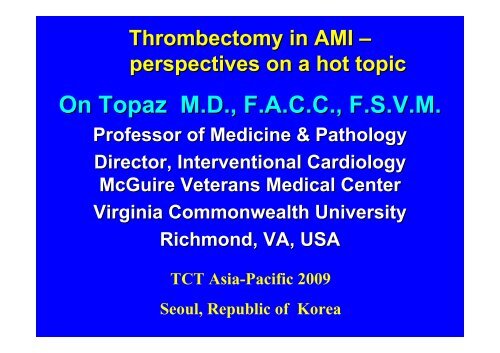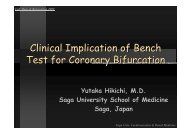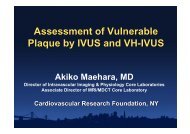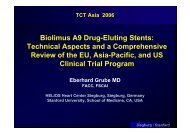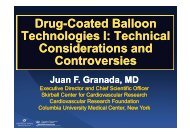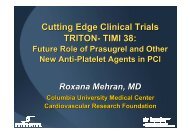On Topaz MD, FACC, FSVM - summitMD.com
On Topaz MD, FACC, FSVM - summitMD.com
On Topaz MD, FACC, FSVM - summitMD.com
You also want an ePaper? Increase the reach of your titles
YUMPU automatically turns print PDFs into web optimized ePapers that Google loves.
Thrombectomy in AMI –<br />
perspectives on a hot topic<br />
<strong>On</strong> <strong>Topaz</strong> M.D., F.A.C.C., F.S.V.M.<br />
Professor of Medicine & Pathology<br />
Director, Interventional Cardiology<br />
McGuire Veterans Medical Center<br />
Virginia Commonwealth University<br />
Richmond, VA, USA<br />
TCT Asia-Pacific 2009<br />
Seoul, Republic of Korea
Thrombectomy in AMI –<br />
The hot topic<br />
1. Sardella et al<br />
The EXPIRA prospective randomized trial<br />
JACC 2009; 53: 309-315<br />
2. Amin et al<br />
J Interv Cardiol 2009; 22: 49-60<br />
3. De Luca et al<br />
Adjunctive manual Thrombectomy<br />
improves myocardial perfusion and<br />
mortality in STEMI: a meta analysis of<br />
randomized trials<br />
Euro Heart J 2008; 29: 3002-3010<br />
4. Chao et al<br />
Benefit of initial Thrombosuction on<br />
myocardial perfusion<br />
Int J Clin Pract 2008; 62: 555-561
Revascularization of Thrombus-Laden Lesions in AMI –<br />
The Burden on the Interventionalist<br />
<strong>On</strong> <strong>Topaz</strong>, <strong>MD</strong><br />
Throughout revascularization of coronary arteries and saphenous vein grafts in acute myocardial infarction (AMI) and acute coronary syndromes, the<br />
burden of a thrombus can be "felt" by interventionalists. You know that ominous "feeling" when angiography demonstrates a large size thrombus — a<br />
notorious marker of procedural <strong>com</strong>plications. And, extensive literature clearly supports your concern, 1-5 because visible thrombus<br />
possesses imminent risk of flow impairment, distal embolization, "no reflow" phenomenon with<br />
microcircular obstruction and infarct expansion. If treated inadequately, thrombus turns into an active, "angry" <strong>com</strong>ponent causing<br />
further flow cessation and at times accounting for development of cardiogenic shock and even death. Can interventionalists discern the presence,<br />
quantify the size of a thrombus and proceed accordingly with a dedicated treatment strategy? The answer is controversial. Traditionally, it has been<br />
shown that angiography has a low sensitivity for detection of intracoronary thrombus, and it is likely that the true incidence of thrombus is<br />
underestimated. 67 However, with recent improved imaging in the cath lab and heightened awareness to visible thrombus and its deleterious effects on<br />
out<strong>com</strong>e, interventionalists seem to have developed a more accurate appraisal of thrombus. When the accuracy of visual assessment of thrombus was<br />
validated by independent core lab QCA analysis, it has been convincingly demonstrated that interventionalists can precisely identify and differentiate<br />
between each level of TIMI thrombus grade and treat accordingly. 8<br />
The best method for the percutaneous undertaking of a large size thrombus in AMI is yet unknown and management strategies vary considerably.<br />
Limited treatment with only heparin is still in use due to severe underestimation of the thrombus hazard. In contrast, attempts at <strong>com</strong>plete thrombus<br />
burden removal with mechanical devices appear to gain momentum. Unfortunately, many in the field still attempt to handle visible large size thrombus<br />
with balloon only, perhaps due to a lingering influence of early days ("When I face a large coronary thrombus I just beat it to death with the balloon,"<br />
was frequendy heard from one of the field's founders). Some continue to treat angiographic thrombus with the quite ineffective glycoprotein Ilb/IIIa<br />
receptor antagonists, 9 ' 10 while others manage visible thrombus with unsubstantiated use of filter protection. 11 Many then naively deploy a stent for<br />
thrombus displacement hoping that it will somehow end up squeezing the thrombus and associated debris selectively onto die vessel's wall. In several<br />
high volume centers, mechanical thrombectomy devices are first in line, frequently in <strong>com</strong>bination with direct coronary injections of low-dose<br />
thrombolytics. 12 Regardless, the burden of the thrombi continues to be high and costly.<br />
In this issue of the journal, Burzotta et al 13 describe early experience of treating thrombus-laden lesions in AMI by applying an aspiration catheter and a<br />
distal protection device. The authors are to be <strong>com</strong>mended for the concept and especially for avoiding the temptation to routinely use a thrombus<br />
removal device for all AMI lesions. They correctly centered their efforts on lesions with significant thrombus load. In con-trast, a Rescue aspiration<br />
catheter was unjustifiably applied in a recent AMI study to all lesions regardless of visible thrombus. 14 A similar mistaken strategy took place in the<br />
rheolytic thrombectomy AIMI study.<br />
The revascularization technique of Burzotta et al incorporated aspiration first, then distal protection followed by stent implantation. The aspiration was<br />
done with a Diver CE catheter that was slowly advanced in aspiration mode along the culprit lesion. <strong>On</strong>ce die syringe was full, the device was retracted<br />
and reintroduced up to six times. The aim was creation of a tunnel within the thrombus which would enable crossing for deployment of a distal<br />
protection filter. While utilization of aspiration devices is simple technically, in our experience they do not provide adequate removal of large size<br />
thrombus, especially multilayered, resistant clot. The frequent need to recross die target several times certainly adds to the risk of distal embolization.<br />
Moreover, from a technological standpoint, to ensure maximal efficiency, an aspiration catheter needs to provide multiple large-sized holes that drain<br />
into a large extraction lumen. This is required to ac<strong>com</strong>modate large thrombus content and its debris. Intriguingly, the present generation of aspiration<br />
catheters are designed to "forcefully" fit into a 6 Fr guiding catheter. Such small lumen diameter probably <strong>com</strong>promises die efficiency of the<br />
abovementioned holes. As for filter protection devices, the concept is attractive but their performance is questionable"; the receiving vessel requires a<br />
landing zone of no less than 3-4 cm, and deployment can be cumbersome. Cont.<br />
Journal of Invasive Cardiology August 2007: Vol. 19; No. 8, pp. 324-325
CCI 2005; 65: 280-281.<br />
CCI 2002; 57: 340-341
Many major STEMI studies do not measure<br />
or grade thrombus burden 1 , this despite<br />
recognition of the structural <strong>com</strong>plexity of<br />
thrombus 2 and its significant effect on PCI<br />
out<strong>com</strong>es 3 .<br />
1. Conti CR Editorial. STEMI: thrombus formation<br />
and prognosis. Clin Cardiol 2008; 31: 3-5<br />
2. Furie B, Furie BC Mechanisms of thrombus<br />
formation. NEJM 2008; 359: 938-949.<br />
3. <strong>Topaz</strong> O Editorial. Revascularization of thrombusladen<br />
lesions in AMI – the burden on the<br />
interventionalist.<br />
J Invas Cardiol 2007; 19: 324-325
Angiographic Stent Thrombosis After Routine Use of Drug-Eluting<br />
Stents in ST-Segment Elevation Myocardial Infarction<br />
The Importance of Thrombus Burden<br />
Georgios Sianos, <strong>MD</strong>, PHD, Michail I. Papafaklis, <strong>MD</strong>, Joost Daemen, <strong>MD</strong>, Sofia Vaina, <strong>MD</strong>, Carlos A. van<br />
Mieghem, <strong>MD</strong>, Ron T. van Domburg, PHD, Lampros K. Michalis, <strong>MD</strong>, MRCP, Patrick W. Serruys, <strong>MD</strong>, PHD,<br />
Objectives<br />
Background<br />
Methods<br />
Results<br />
Conclusions<br />
This study sought to investigate the impact of thrombus burden on the clinical out<strong>com</strong>e<br />
and angiographic infarct-related artery stent thrombosis (IRA-ST) in patients routinely<br />
treated with drug-eluting stent (DES) implan-tation for ST-segment elevation myocardial infarction<br />
There are limited data for the safety and effectiveness of DES in STEMI.<br />
We retrospectively analyzed 812 consecutive patients treated with DES implantation for<br />
STEMI. Intracoronary thrombus burden was angiographically estimated and categorized as<br />
large thrombus burden (LTB), defined as thrombus burden >2 vessel diameters, and small<br />
thrombus burden (STB) to predict clinical out<strong>com</strong>es. Major adverse cardiac events (MACE)<br />
were defined as death, repeat myocardial infarction, and IRA reintervention.<br />
Mean duration of follow-up was 18.2 ± 7.8 months. Large thrombus burden was an<br />
independent predictor of mortality (hazard ratio [HR] 1.76, p = 0.023) and MACE (HR 1.88, p =<br />
0.001). The cumulative angiographic IRA-ST was 1.1% at 30 days and 3.2% at 2 years, and<br />
continued to augment beyond 2 years. It was significantly higher in the LTB <strong>com</strong>pared with<br />
the STB group (8.2% vs. 1.3% at 2 years, respectively, p < 0.001). Significant independent<br />
predictors for IRA-ST were LTB (HR 8.73, p < 0.001), stent thrombosis at presentation (HR<br />
6.24, p= 0.001), bifurcation stenting (HR 4.06, p = 0.002), age (HR 0.55, p = 0.003), and rheolytic<br />
thrombectomy (HR0.11, p = 0.03).<br />
Large thrombus burden is an independent predictor of<br />
MACE and IRA-Stent Thrombosis in patients treated with<br />
DES for STEMI.<br />
(J Am Coll Cardiol 2007;50:573-83)
Thrombus by Angioscopy<br />
Red Thrombus White Thrombus Fibrous Plaque<br />
Abela GS, et al. Am J Cardiol 1999; 83: 94-97
The massive hostile thrombus
Johnstone E et al J Thromb Thrombolysis 2007: 24:233-239<br />
(A)<br />
(C)<br />
(B)<br />
(D)<br />
Fig. 6 (A) Light micrograph of a white thrombus overlying a plaque on the intimal surface of the rabbit aorta<br />
(Movat's pentachrome stain, platelets stain red, magnification x 160). This demonstrates a dense thrombus with no<br />
loose inner spaces. (B) Light micrograph of a red thrombus overlying a plaque on the intimal surface of the aorta<br />
(Movat's pentachrome stain, magnification x 180). This demonstrates a dense surface thrombus layer with loose<br />
inner core. (C) Transmission electron micrograph of a white thrombus demonstrating a high concentration of<br />
platelets with fibrin and few red blood cells (Magnification = 3.4 x 2.5). (D) Transmission electron micrograph of red<br />
thrombus with loosely packed fibrin and many interspersed red blood cells (Magnification = 3.4 x 2.5)<br />
(D)
PCI versus Thrombolysis in<br />
STEMI<br />
PCI in STEMI is superior to thrombolysis.
Myocardial Blush Score<br />
TIMI-3 flow was restored in 94% of patients treated<br />
with PTCA after AMI – in contrast, normal perfusion<br />
was restored in only 28%:<br />
Myocardial Blush Scores<br />
Following PTCA in AMI<br />
0/I<br />
30%<br />
II<br />
42%<br />
III<br />
28%<br />
Mortality<br />
20.00%<br />
18.00%<br />
16.00%<br />
14.00%<br />
12.00%<br />
10.00%<br />
8.00%<br />
6.00%<br />
4.00%<br />
2.00%<br />
0.00%<br />
0/I II<br />
III<br />
Myocardial Blush Score<br />
Impaired perfusion despite normal<br />
epicardial coronary flow is consistent<br />
with microvascular obstruction due<br />
to microembolization.<br />
Reduced myocardial blush correlates<br />
with an increased risk of death.<br />
Stone GW, et al. Abstract AHA. November 1999.
Limitations of PCI in AMI<br />
“ The illusion of reperfusion ”<br />
33% of post-PCI patients show a discrepancy<br />
between :<br />
PCI induced vessel patency vs. suboptimal<br />
degree of rescued myocardium.<br />
1) Lincoff AM, Topol EJ “illusion of reperfusion”<br />
Circulation 1993:88:1361-1374<br />
2) Vont Hof AWJ Circulation 1998:97:2302-2306
Cause of discrepancy: damage to<br />
microvascular circulation<br />
Contributing factors:<br />
• endothelial damage<br />
• tissue edema<br />
• release of vasoconstrictive & inflammatory mediators<br />
• leukocyte plug<br />
Thrombus:<br />
• platelet & fibrin aggregates<br />
• embolization<br />
Michaels AD et al. Am J Cardiol 2000:85:50b-60b<br />
Henriques JP et al. Eur Heart J 2002:23:1112-1117
Adjunct pharmacotherapy for<br />
thrombus burden in AMI<br />
Traditional:<br />
•ASA, Plavix, heparin<br />
•Direct thrombin inhibitor<br />
•IIb/IIIa Receptor Antagonists
Platelet IIb/IIIa inhibitors less<br />
effective in angiographic thrombus<br />
Silva JA et al CCI 2002; 56:8-9.
Adjunct pharmacotherapy for<br />
thrombus burden in AMI<br />
Emerging role for intracoronary treatment:<br />
Adenosine, Ca channel blockers, α-blockers, β2-<br />
receptor activators, vasodilators &<br />
direct thrombolytics.<br />
Kundadian V, C.Michael Gibson et al.<br />
J Thrombosis Thrombolysis 2008; 26: 234-242
“ The Quest “<br />
“An unequivocal clinical need exists<br />
for a thrombectomy device that<br />
can safely improve clinical out<strong>com</strong>es<br />
in patients with thrombus<br />
containing lesions.”<br />
Stone G et al. JACC 2003:42:2007-2013
Mechanical tools for thrombus<br />
management in AMI<br />
Poor<br />
Acceptable<br />
Good<br />
Good<br />
Rarely used<br />
Compression<br />
Aspiration<br />
Extraction<br />
Ablation<br />
Dissolution<br />
Balloon<br />
Export, Diver, Fetch<br />
AngioJet, X-Sizer<br />
Laser<br />
Ultrasonic Energy
Advantages of Thrombectomy Devices<br />
in AMI<br />
Direct contact with thrombus & underlying<br />
plaque<br />
Significant thrombus-burden & pro-coagulant<br />
removal<br />
Shorten D2TIMI 3 time<br />
Cont.
Advantages of Thrombectomy Devices<br />
in AMI<br />
• Rapid restoration of epicardial flow, lowering<br />
cTFC, improving myocardial blush score 1<br />
• Acceleration of ST-segment resolution.<br />
• Reduced rate of distal embolization and “no<br />
reflow” 2<br />
• Improved 1 yr. survival rate (range 90 – 96%)<br />
1. Beran et al. Circulation 2002: 105: 2355-2360<br />
2. Napodano et al. J Am Coll Cardiol 2003: 42: 1395-1402
<strong>Topaz</strong> et al<br />
Am J Cardiol 2004; 93: 694-701<br />
QCA PER TIMI THROMBUS<br />
GRADE<br />
# of patients<br />
0<br />
No<br />
Thrombu<br />
s<br />
11<br />
1<br />
Small<br />
Thrombus<br />
14<br />
2<br />
Medium<br />
Thrombus<br />
28<br />
3<br />
Large<br />
Thrombus<br />
45<br />
4<br />
Extensive<br />
Thrombus<br />
63<br />
MLD:<br />
Baseline (mm)<br />
.87±.69<br />
.72±.43<br />
.65±.45<br />
.59±.49<br />
.37±.49<br />
Post laser<br />
1.74±.46<br />
1.48±.49<br />
1.51±.51<br />
1.50±.41<br />
1.62±.62<br />
Laser acute<br />
gain<br />
.90±.63<br />
.76±.52*<br />
.84±.60<br />
.94±.48<br />
1.21±.72*<br />
Final<br />
2.97±.60<br />
2.54±.55<br />
2.47±.62<br />
2.62±.55<br />
2.76±.62<br />
%DS:<br />
Baseline<br />
Post laser<br />
74%±21%<br />
47%±13%<br />
76%±16%<br />
51%±11%<br />
77%±16%<br />
52%±15%<br />
82%±16%<br />
51%±13%<br />
89%±15%<br />
53%±17%<br />
Laser acute<br />
reduction<br />
27%±18%<br />
25%±15%<br />
25%±19%<br />
31%±16%<br />
36%±20%<br />
Final<br />
16%±17%<br />
15%±13%<br />
22%±14%<br />
16%±17%<br />
22%±16%<br />
* p=0.03
The NEW ENGLAND JOURNAL of MEDICINE<br />
February 7, 2008 Vol 358; No. 6: 557-67<br />
Thrombus Aspiration during Primary Percutaneous Coronary Intervention<br />
Tone Svilaas, M.D., et al.<br />
ABSTRACT<br />
BACKGROUND<br />
Primary percutaneous coronary intervention (PCI) is effective in opening the infarct-related artery in patients with myocardial<br />
infarction with ST-segment elevation. How-ever, the embolization of atherothrombotic debris induces microvascular obstruction<br />
and diminishes myocardial reperfusion.<br />
METHODS<br />
We performed a randomized trial assessing whether manual aspiration was superior to conventional treatment during primary PCI. A total of 1071<br />
patients were randomly assigned to the thrombus-aspiration group or the conventional-PCI group before un-dergoing coronary angiography.<br />
Aspiration was considered to be successful if there was histopathological evidence of atherothrombotic material. We assessed angio-graphic and<br />
electrocardiographic signs of myocardial reperfusion, as well as clini-cal out<strong>com</strong>e. The primary end point was a myocardial blush grade of 0 or 1<br />
(defined as absent or minimal myocardial reperfusion, respectively).<br />
RESULTS<br />
A myocardial blush grade of 0 or 1 occurred in 17.1% of the patients in the throm-bus-aspiration group and in 26.3% of those in the conventional-<br />
PCI group (P
Feasibility of Sequential Thrombus Aspiration and Filter Distal Protection in<br />
the Management of Very High Thrombus Burden Lesions<br />
Francesco Burzotta, <strong>MD</strong>, et al<br />
ABSTRACT: Background. A series of thrombectoy and distal filter devices<br />
have been developed to limit distal embolization during percutaneous coronary<br />
interventions (PCI). Objective. To evaluate the feasibility of the <strong>com</strong>bined use of<br />
thrombus-aspirating catheters and dis-tal filter devices in patients at high risk of<br />
no-reflow. Methods. Throm-bus aspiration (TA) and distal filter protection (DFP)<br />
were sequentially used in a series of patients undergoing urgent PCI within 48<br />
hours of acute myocardial infarction (MI). Inclusion criteria were: (1) occlusion<br />
of die infarct-related artery; (2) at least 2 out of the 6 Yip's classification features<br />
of high thrombus burden. Coronary angiograms were evaluated off-line to assess<br />
thrombus score, coronary flow and distal embolization in different phases of the<br />
procedure. Results. TA followed by DFP prior to balloon dilatation or stent<br />
implantation was successfully per-formed in 20 patients with acute MI due to<br />
occlusion of de nova lesions (80%) or in-stent thrombosis (20%) located in a<br />
native coronary artery (90%) or a saphenous vein graft (10%). TA was associated<br />
widi a signif-icant acute reduction of TS and improvement of coronary flow<br />
(TIMI grade from 0.7 ± 0.8 to 1.6 ± 1.1; p = 0.004 and CTFC from 83 ± 29 to<br />
52 ± 36; p = 0.006). This facilitated the deployment of DFP, which did not<br />
induce significant flow modification (TIMI grade: 2.3 ± 0.9 pre-DFP placement<br />
vs. 2.2 ±1.0 post-DFP placement; p = 0.20; CTFC: 32 ± 28 pre-DFP placement<br />
vs. 35 ± 28 post-DFP placement; p= 0.47). Post-PCI angiography revealed a 90%<br />
TIMI 3 flow rate and 47% MBG 3 rate with only 1 case of angiographically<br />
evident distal embolization. Conclusions. Sequential use of TA<br />
and DFP may be successfully used during PCI<br />
in patients at very high risk of distal<br />
embolization. However, the possible benefits of such an approach<br />
should be weighted with the increased <strong>com</strong>plexity of the procedure. Further<br />
evaluations of the clinical efficacy of this approach are needed. J INVASIVE<br />
CARDIOL 2007; 19:317-323
Efficacy X-sizer X<br />
(Core lab)<br />
X-sizer success * 87 %<br />
Thrombus removal 95%<br />
*Successful delivery X-SIZER to target site and TIMI flow improvement > 1 grade.<br />
Lefevre T et al JACC 2005; 46: 246-52
A<br />
B<br />
C<br />
D<br />
E
FDA approved device
AngioJet® Ultra<br />
Thrombectomy System<br />
The new AngioJet Ultra<br />
console features automated<br />
set-up and supports a wide<br />
range of catheters with all<br />
disposable elements<br />
integrated into single-package<br />
thrombectomy sets.
Saline jets inside the AngioJet® catheter travel<br />
backwards at high speed to create a negative pressure<br />
zone. The Cross-steam ® windows optimize fluid flow,<br />
drawing thrombus into the catheter where it is<br />
fragmented and removed from the body.<br />
AngioJet® Family of Thrombectomy Catheters<br />
4 french to 6 french with indications for<br />
coronary and peripheral arterial thrombectomy<br />
and AV declot
Rheolytic Thrombectomy With<br />
Percutaneous Coronary Intervention for<br />
Infarct Size Reduction in Acute Myocardial Infarction<br />
30-Day Results From a Multicenter Randomized Study<br />
Arshad All, <strong>MD</strong> et al.<br />
OBJECTIVES<br />
BACKGROUND<br />
METHODS<br />
The goal of this work was to determine whether rheolytic thrombectomy (RT) as an adjunct to<br />
primary percutaneous coronary intervention (PCI) reduces infarction size and improves myocardial<br />
perfusion during treatment of ST-segment elevation myocardial infarction (STEMI).<br />
Primary PCI for STEMI achieves brisk epicardial flow in most patients, but myocardial perfusion<br />
often remains suboptimal. Distal embolization of thrombus during treatment may be a contributing<br />
factor.<br />
This prospective, multicenter trial enrolled 480 patients presenting within 12 h of symptom<br />
onset and randomized to treatment with RT as an adjunct to PCI (n = 240) or to PCI alone<br />
(n = 240). Visible thrombus was not required. The primary end point was infarct size<br />
measured by sestamibi imaging at 14 to 28 days. Secondary end points included final<br />
Thrombolysis In Myocardial Infarction (TIMI) flow grade, tissue myocardial perfusion<br />
(TMP) blush, ST-segment resolution, and major adverse cardiac events (MACE), defined as<br />
the occurrence of death, new Q;wave myocardial infarction, emergent coronary artery bypass<br />
grafting, target lesion revascularization, stroke, or stent thrombosis at 30 days.<br />
RESULTS Final infarct size was higher in the adjunct RT group <strong>com</strong>pared with PCI alone (9.8 ±<br />
10.9% vs. 12.5 ± 12.13%; p = 0.03). Final TIMI flow grade 3 was lower in the adjunct<br />
RT group (91.8% vs. 97.0% in the PCI alone group; p < 0.02), although fewer patients<br />
had baseline TIMI flow grade 3 in the adjunct RT group (44% vs. 63% in the PCI alone<br />
group; p < 0.05). There were no significant differences in TMP blush scores or<br />
ST-segment resolution. Thirty-day MACE was higher in the adjunct RT group (6.7% vs.<br />
1.7% in the PCI alone group; p = 0.01), a difference primarily driven by very low<br />
mortality rate in patients treated with PCI alone (0.8% vs. 4.6% in patients treated with<br />
adjunct RT; p = 0.02).<br />
CONCLUSIONS Despite effective thrombus removal, RT with primary PCI did not reduce infarct size<br />
or improve TIMI flow grade, TMP blush, ST-segment resolution, or 30-day MACE.<br />
J Am Coll Cardiol 2006;48:244-52
Benefits of rheolytic thrombectomy in patients with<br />
STEMI and high thrombus burden: findings from the<br />
cardioquest interventional database<br />
Low Thrombus High Thrombus High Thrombus<br />
n=223 AJet n=53 No AJet n=122<br />
30-d mortality 13 (5.8%) 5 (9.4%) 17 (13.9%) p=NS<br />
Angiographic 24 (10.8%) 8 (15.1%) 49 (40.2%) p=0.001<br />
adverse events<br />
F Matar et al Cardiovasc Revasc Med 2008; 9: 113-114.
Angiojet Rheolytic Thrombectomy During Rescue PCI for<br />
Failed Thrombolysis: A Single-Center Experience<br />
Dimitri A. Sherev, <strong>MD</strong> et al.<br />
ABSTRACT: Background. Previous studies have shown the efficacy of Angiojet 9 Rheolytic<br />
Thrombectomy (RT) in reducing thrombus burden and improving coronary flow in acute myocardial<br />
infarction (MI). No study has specifically evaluated the use of Angiojet RT in patients undergoing rescue<br />
percutaneous coronary intervention (PCI) for failed thrombolysis, a setting that may be particularly<br />
beneficial given the extensive thrombus burden. The objective of this study was to evaluate the efficacy<br />
and safety of Angiojet RT during rescue PCI for failed thrombolysis. Methods. 214 consecutive patients<br />
were transferred to Good Samaritan Hospital to undergo rescue PCI for failed thrombolysis from January<br />
2000 to October 2004. From this cohort, 32 patients (age 57 ± 9, 30% male) undergoing Angiojet RT for<br />
rescue PCI (RT group) were identified and matched by initial thrombolysis in MI (TIMI) flow and infarct<br />
related artery (IRA) location to 32 patients (age 60 ± 12, 24% male) undergoing rescue PCI without<br />
Angiojet RT (Control group). TIMI frame count and TIMI thrombus grade were assessed at initial and final<br />
angiography. Angiographic success (TIMI 3 flow, < 50% residual stenosis) and in-hospital clinical events,<br />
including bleeding <strong>com</strong>plications and major adverse cardiac events (MACE) such as death, recurrent MI,<br />
target vessel revascularization and emergent bypass surgery were evaluated. Clinical success was<br />
defined as angiographic success in the absence of MACE. Results. Baseline clinical characteristics were<br />
similar in both groups, except patients undergoing Angiojet RT were more likely to be males and less<br />
likely to be intubated on transfer. 30/32 (94%) patients achieved a TIMI thrombus grade of 0 in the RT<br />
group, <strong>com</strong>pared to 22/32 (69%) in the Control group. Final IRA TIMI frame count was similar in the RT<br />
<strong>com</strong>pared to the Control group (33 ± 21 vs. 38 ± 23, p NS, respectively). The occurrence of no reflow was<br />
significantly lower in the RT <strong>com</strong>pared to the Control group (13% vs. 56%, p < 0.001, respectively). There<br />
was a trend for higher angiographic success in the RT <strong>com</strong>pared to the control group (93% vs. 78%, p =<br />
0.07, respectively). Clinical success was higher in the RT <strong>com</strong>pared to the Control group (91% vs. 71%,p<br />
= 0.05, respectively). There were no differences in bleeding <strong>com</strong>plications or MACE between the groups.<br />
Conclusion: Angiojet RT in high-risk patients undergoing rescue<br />
PCI for failed thrombolysis is safe and more effective in<br />
decreasing thrombus burden and preventing no reflow than<br />
conventional PCI.<br />
J Invasive Cardiol 2006; 18: 12c-16c
Thrombectomy devices in AMI
Thrombectomy devices in AMI
Thrombectomy devices in AMI
Conclusions:<br />
TCT ASIA-PACIFIC 2009<br />
Thrombectomy in AMI – Perspectives on a Hot Topic<br />
• State-of-the-art AMI management should include a dedicated<br />
[mechanical ?] thrombectomy strategy.<br />
• Thrombectomy devices provide direct thrombus contact, safe &<br />
effective extraction.<br />
• Thrombus removal in AMI improves TIMI flow, ST- segment<br />
resolution, myocardial blush and cTFC.<br />
• Re-emerging technique: Power Thrombolysis – incorporation of<br />
thrombectomy devices with direct lytics.<br />
• Finally, In order to achieve its goal, the most important aspect<br />
of thrombectomy is…


